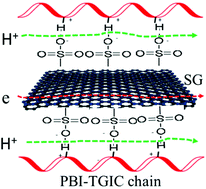Elevated-temperature H2 separation using a dense electron and proton mixed conducting polybenzimidazole-based membrane with 2D sulfonated graphene†
Abstract
Hydrogen (H2) is a clean energy carrier and its cost-effective separation is important for future H2 energy deployment. Currently, H2 is mainly produced from high temperature methane steam reforming reactions and thus the availability of membrane separation technology that can work at elevated temperatures can reduce the production cost. In this work, a cross-linked polybenzimidazole (PBI)-triglycidylisocyanurate (TGIC) and sulfonated graphene (SG) composite membrane was developed using a mixed proton–electron conducting concept. In such a membrane, protons diffuse by hopping along the cross-linking sites between the sulfonic groups of SG and the pyrrole rings of PBI, while electrons are transported via highly electron conductive SG. Following the addition of SG, the membrane became more compact, given the reduced interlayer spacing and swelling ratio. The thermal stability and oxidative resistance are comparable to those of other PBI-based membranes. For H2/CO2 separation, H2 can permeate through a 132 μm-thick membrane with 99.99% selectivity and a high flux of up to 0.22 mL min−1 cm−2 at 300 °C. The stable operation at 280 °C for 160 hours proves the membrane robustness at such an elevated temperature. Compared to the previously reported mixed conducting ceramic membranes exhibiting equivalent H2 fluxes requiring operation temperatures above 800 °C, the polymer and graphene composite membrane presented herein can reduce the operation temperature by 500 °C. This is an important requirement to ensure a more practical integration of membrane technology into industrial processes.



 Please wait while we load your content...
Please wait while we load your content...